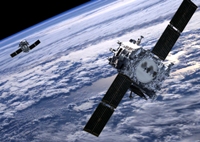Stereo to see the Sun in 3D

Deployment of Stereo space craft panels. Credit: Dr C.J.Eyles, University of Birmingham
26 October 2006
Thursday 26 October 2006
Stereo to see the Sun in 3D
Scientists at one of the UK's leading solar research groups are set to play a leading role in NASA's STEREO mission which will provide the first ever 3D views of the Sun.
STEREO (Solar TErrestrial RElations Observatory) comprises two nearly identical observatories that will orbit the Sun to monitor its violent outbursts Coronal Mass Ejections (CMEs) and the space weather it creates that can impact the Earth, satellites and astronauts. STEREO was successfully launched this morning, Thursday 26th October 2006.
Dr Andy Breen is a leading member of the solar System Physics Research Group at the Institute of Mathematical and Physical Sciences, the University of Wales, Aberystwyth and a co-investigator on the mission’s SECCHI instrument (Sun Earth Connection Coronal and Heliospheric Investigation).
SECCHI is a set of 5 telescopes on each space craft that will observe the inner part of the Sun’s atmosphere in ultraviolet light and the outer atmosphere, which extends beyond the Earth, in white light. Dr Breen has developed a series of experiments which are designed to look out for solar storms as they move out from the Sun towards the Earth.
The twin STEREO observatories orbit the Sun such that one spacecraft is ahead of the Earth and the other is behind it. Because the high-gain dish antennas need to be pointed at Earth for command and telemetry, one spacecraft must fly "upside down" relative to the other. This requires the identical instruments on each craft to be placed in slightly different locations. Also one observatory's main structure is a little thicker so that it can support the weight of the second observatory during launch. The slightly larger observatory will retain a portion of the separation fitting or ring used to connect the two during their ride into space.
http://www.pparc.ac.uk/Nw/prelaunch_stereo.asp .
The Solar System Physics research group at the University of Wales, Aberystwyth has made a significant contribution to understanding the solar wind and its effects on the Earth. The late Professor Phil Williams was one of the first to successfully measure the velocity of solar wind as it flows away from the Sun.
With the appointment of Professor Manuel Grande, who recently joined the University from the Rutherford Appleton Laboratory where he was Leader of the Planets and Space Plasmas group, the group will extend its field of study to include the study of the effects of the solar wind on Mars, Venus and Mercury. Professor Grande is also one of the lead scientists on Aspera 4 which forms part of the Venus Express mission.
Venus Express was launched in November 2005 and successfully entered orbit around Venus in April 2006. http://www.aber.ac.uk/aberonline/en/archive/2006/04/uwa4306/ .
Coronal Mass Ejection (CME) / Solar storm incidents
In 1859 a giant solar storm erupted hurtling hot plasma in the form of a Coronal Mass Ejection (CME) toward the Earth. As this was before the space age, the main effect was disruption to telegraph lines and sightings of aurora in unusual locations. If such a storm were to be repeated today, the effects would be more dramatic as satellites ringing the Earth would take the brunt of the impact! Forecasts suggest that such a major outburst from the Sun would have a similar economic impact to a category 5 hurricane! The 1859 storm is also significant because it was the first occasion when scientists directly linked a solar flare to the aurora seen on Earth 12 hours later. This was observed by UK scientist Richard Carrington for which he was honoured by the Royal Astronomical Society.
August 1972 saw a solar storm that is legendary at NASA. It occurred between two Apollo missions, with one crew just returned from the Moon and another preparing for launch. If an astronaut had been on the Moon at the time, they might have received a 400 rem (Roentgen Equivalent man) radiation dose. Not only would this have caused radiation sickness, but without rapid medical treatment such a sudden dose could be fatal. Astronauts on the ISS are safer as spaceships provide considerable shielding from solar storms and the ISS is within the protective magnetic field of the Earth. Humans exploring the Moon or Mars need carefully designed shelters that can protect them without the benefit of a magnetic field.
CMEs can also affect power grids. On March 13th 1989, a CME hitting the Earth caused magnetic disruptions that induced currents in the power grid. This caused a series of transformers to trip, leaving 6 million people in Quebec without power, as well as knocking out the power in other countries.
A particularly violent CME occurred on October 31st 2003. This blinded Mars Express for a day and significantly degraded the solar panels on a number of spacecraft including Mars Express, SOHO and Cluster. CMEs also interfere with radio systems that use the ionosphere to reflect signals over long distances



